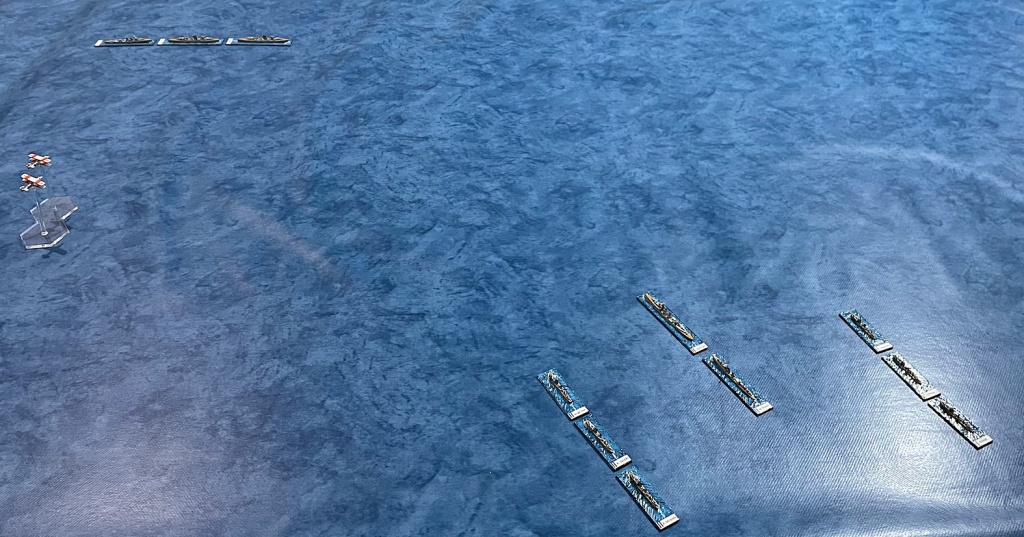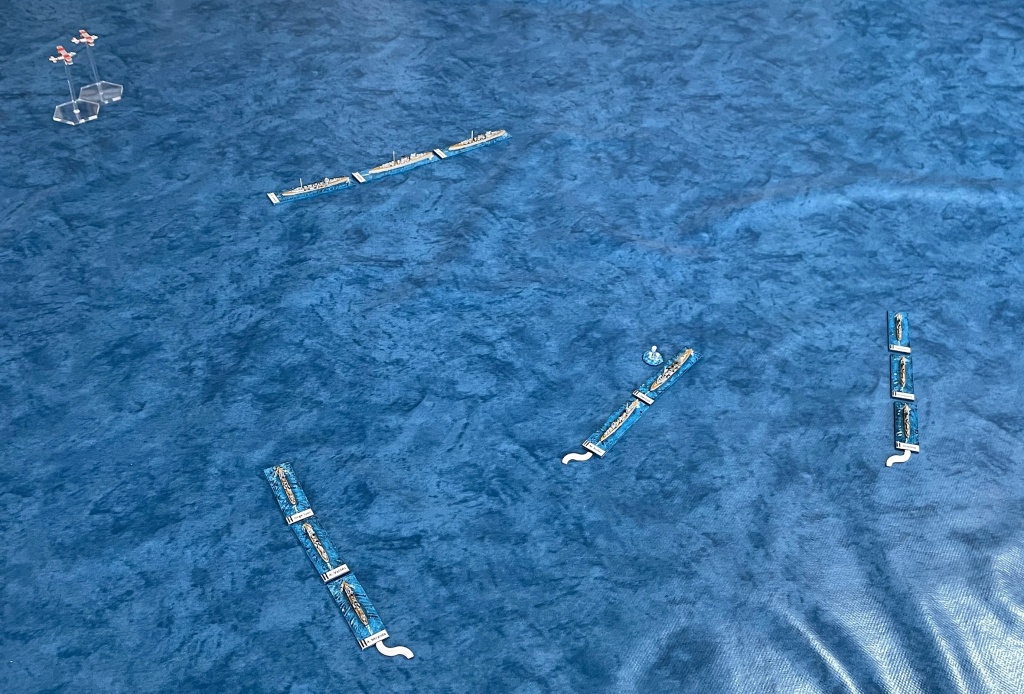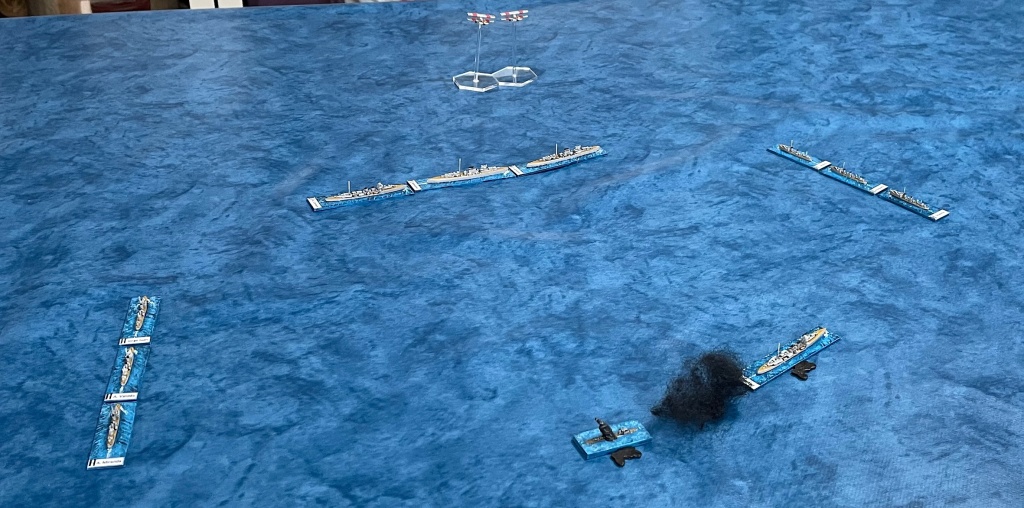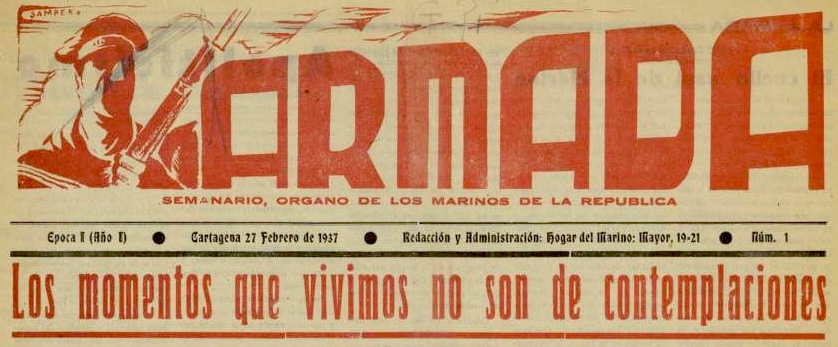The Rules
Find, Fix and Strike was written by David Manley and published under his imprint Long Face Games in 2019. It is available as a pdf of 48 black and white pages for $10 from wargamevault.com. David is a prolific writer of naval wargames rules and has published sets covering almost any period you can imagine, some quite obscure. He is a naval architect by profession, so he knows his stuff.
Find, Fix and Strike is a heavily abstracted game intended for fast play on a normal wargames table. This means that the ground scale is large, with 1″ representing 1.000 yards. One turn represents 6 minutes of real time.
Movement is alternating, with the player with initiative deciding who will go first with a ship or squadron. Turning is pretty generous: ships smaller than battleships may turn up to 180° at the beginning of their movement or up to 90° at the beginning and at the end.
Shooting is also alternating, with the effects taking place immediately. Find, Fix and Strike uses a damage model similar to many other of David’s fast play rules: an opposed dice roll determines whether damage was inflicted by firing and an escalating damage ladder indicates the effects of the damage on the ship. There are no “hull points” or similar quantitative ways of keeping track of damage. Instead, damage is strictly recorded in qualitative steps, from light to heavy, crippled, silence and sunk. Each step has effects on the ship’s performace, such as penalties for shooting, defending or moving. There are also critical hits, which happen if the defender takes damage while rolling a natural 1.
Each capital ship has an abstract attack value for its main guns and another one for the secondary light guns (destroyers only have light guns), as well as an anti-aircraft value. Armour and penetration is taken into account not only by a ship’s defense value, but also by a table which indicates which caliber of gun will cause significant damage at which distance. If a gun is unable to penetrate the enemy’s armour, it will cause no more than light damage.
The game allows cruisers and smaller ship to make evasive manoeuvres, which make them considerably harder to hit but make it impossible to shoot or launch torpedos. It also allows to generate smoke, which blocks line of sight.
The game features rules for air operations to be played out on the table top as part of a tactical battle.
The rules also include a complete campaign system, which is based on a hex map. The author recommends using an umpire, but the campaigns could be easily modified to work without one, as David has indeed done in some of the separately available campaign packs.
All in all, the rules are very comprehensive for such a small book, covering most of the things a player is going to come across in WW2 naval combat. Only submarine operations have been excluded, as they rarely happened during tactical surface combat.
Support
The rules are very well supported, especially for such a small publisher. David has published four campaign packs, which are available for free on wargamevault. He is also very active in the naval wargaming community. There is a dedicated Long Face Games Naval Wargaming group on Facebook, where David himself is present. He is a very approachable and generous person and always willing to answer questions and help out a player.
The game
For more information about the scenario, please see the last post.
Our game started with the lead elements of each fleet sighting each other at 22.000 yards distance. The Vildebeests, which had been shadowing the Nationalists, hovered around and waited for their opportunity. Playing the Republian commander, I decided to start the air attack only when enemy ships were damaged, as this would increase the chance of a torpedo hit.

As the range was still too large to cause significant damage by gunfire, I decided to close it as fast as possible. All my ships made evasive manoeuvres. My opponent Stephan concentrated the fire of his cruisers on my cruisers, ignoring the destroyers for the moment. Splashes came dangerously close, but nothing was hit so far.

While Stephan tried to keep the distance open, I strove to close it. With the generous turning allowances, this basically meant that we shifted our cruiser squadrons parallel. As the nationalists had an already damaged cruiser with slower speed (one of the scenario parameters), I slowly crept closer. When I was in range for doing serious damage, I stopped evading and started shooting. I did manage to lightly damage Canarias, but a lucky hit from Baleares crippled Méndez Núñez and caused flooding.

Generating smoke to cover Méndez Núñez, Libertad stopped closing the distance. The destroyers still rushed forward, but now came under fire from the enemy. Libertad took another hit and was now heavily damaged. As a last effort, I decided to make a torpedo attack with the Vildebeests, hoping that they were lucky enough to hit the damaged Canarias.

However, the anti-aircraft fire by the two enemy heavy cruisers was too much and the Republican pilots abandoned their torpedo run. And, to top it all, Libertad was hit again, this time causing crippling damage and flooding. While the damage control team on Libertad managed to contain the flooding, their comrades on Méndez Núñez were not so lucky and the ship vanished below the waves.

At this point, we decided to end the game. Stephan had achieved his objective of taking out the Republican cruisers and didn’t want to linger around to find out if a destroyer was lucky enough to hit with a torpedo. I decided that the Republican destroyers would abandon their attack, cover the crippled Libertad and rescue sailors from the unfortunate Méndez Núñez. The planes tried one last torpedo attack, but again were driven off by heavy anti-aircraft fire.
First Thoughts
This was a brutal game for the Republicans. We agreed that the difference between the attack factor of 2 for the Republican cruisers and 3 for Canarias and Baleares makes quite a difference with opposed dice rolls, and the heavier armour of the Nationalist cruisers also played a significant role, as it forced me to close the distance before I could even think of damaging the enemy ships. This is historically plausible, as the Republicans had a huge respect for the modern Canarias-class cruisers, which outgunned them severely.
However, we also agreed that luck plays a large role in the opposed dice roll mechanic, especially once ships are damaged and modifiers are reduced.
I don’t think the Republican player has a lot of tactical choices here. I could have kept the cruisers back and tried a torpedo attack with the destroyers first, or at least aim for a better coordination between my squadrons… The aircraft never had much of a chance, which is why I initially planned to keep them back to deliver the coup de grâce to a damaged cruiser, but I never got that far.
After some initial hick-ups (which were mainly caused by me being unconcentrated for some reason and forgetting a couple of things), the game played very smoothly. We played for about one and a half hours, but I guess with more practice we can be much faster for a game of this size. If you want to try it yourself, the ship stats for the scenario can be found in the resources section of the blog or here.
I will talk about my thoughts about the rules in detail in the final installation of this series, so I won’t do it now. Let me just say that I had a lot of fun playing the game, even if I was on the losing side, and there is a lot I like about the rules!












